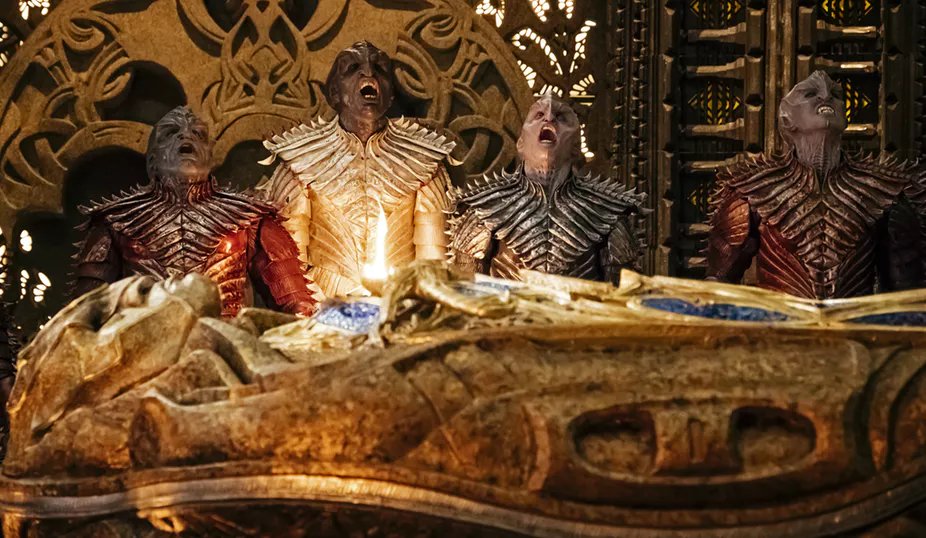MessageToEagle.com – Star Trek has always reflected the contemporary political atmosphere and ideologies in which it is created. From the original series in the 1960s with its peace, love and interracial kiss, to the 1990’s post-Cold War Next Generation, the world-view of progressive Western ideology has featured strongly in the stories of everyone’s favourite group of space explorers.
A ship of klingons. Netflix/Jan Thijs
Across each new iteration, the Klingons – a humanoid warrior species – have often been the alien of choice. The 1960s Klingons were bad, untrustworthy, duplicitous enemies, but visually they looked pretty close to the sapiens on the Starship Enterprise. They were the “other”, but that “other” was also us. They were the Cold War Soviets mixed with a bit of the Japanese from World War II (another enemy, the Romulans, also wore that hat).
See also:
Star Trek Fans: Enjoy “The Good Of The One” – A Great Musical Tribute To Leonard Nimoy
Can Nanotechnology Help Us Create A Perfect Society?
In Star Trek: The Next Generation, the Klingons were more physically differentiated by exo-skeletal additions but they were friends now, not enemies any more, and although slightly erratic allies they fought on the same side as the Federation. It was the post-Cold War world.
Us and them
So what to make of the new Netflix series Discovery and its version of the Klingons? Set further in the past than the other series, watchers have been given a race of new/old Klingons which is physically extraordinary, kitted out like badass Egyptian warriors. Gone are progressive views of understanding the commonalities of our existence. The classical “us” and the space age “other” has been reborn.

What is so intriguing about these new Klingons is that they exhibit all the extremes of real-life exotic enemies from timeless representations going back to the ancient Greeks.
They are portrayed as incomprehensible beasts to the federation: the Klingons participate in self-harm, believe in rebirth in flames, and have a physical appearance that has extended their exo-skeleton to make them look more like wild animals than anthropomorphic beings.
They appear like beasts, as exotic as Durer’s famous drawing of a rhinoceros was to his 16th-century audience.
The new Klingon uniform was clearly inspired by ancient Egyptian breastplates, wired like ribs across their shoulders and upper chest.
Ancient monsters
Though their appearance may be drawn from history, these new, hostile Klingons are base zealots and unrelentingly evil – with an obvious comparison to be made with Islamic State. They are simply our enemy: we possess no shared values, they lie in ambush and react with unremitting violence across the first episodes.
The federation officers of the Discovery series are conflicted about reacting to the aggression – and as such are depicted at first as wishy-washy and weak. The ideals of the previous series, including the “prime directive” – that crews must not interfere with the development of civilisations – have disappeared and are replaced by sneering Klingons who seek martyrdom and mock the concept of “coming in peace”.
I wonder what Star Trek’s creator Gene Roddenberry would have felt about this easy dismissal of the ideals of peaceful inter-species cooperation? In the new Star Trek, violence is the only means to counter violence. For the creators it makes it much easier to accept this by physically placing the Klingons further back in our human past. Their representation in costume like exotic, alien ancients, and practice of a cult of death, further distances them from our so-called “Western” humanity.
By physically animalising the Klingons this becomes an easy retreat to the mythical beasts of old. As the monstrous Gorgon sisters were to the ancient Greeks these Klingons are to the Federation.
This new form of Klingon enemy seems to be reflecting shifting attitudes towards peace and war in today’s world.
More than anything this only serves to confirm how far our society has shifted away from hope and idealism for the future. It will be interesting to see how this new Klingon war is resolved in the next chapter of the first season, and whether hopeful aspiration will return or fear of the other is all we can aspire to.
MessageToEagle.com
Eve MacDonald – Lecturer in Ancient History, Cardiff University
This article was originally published on The Conversation. Read the original article.







